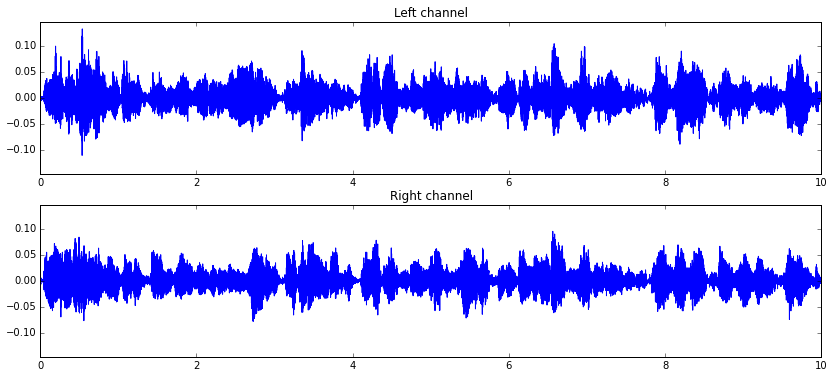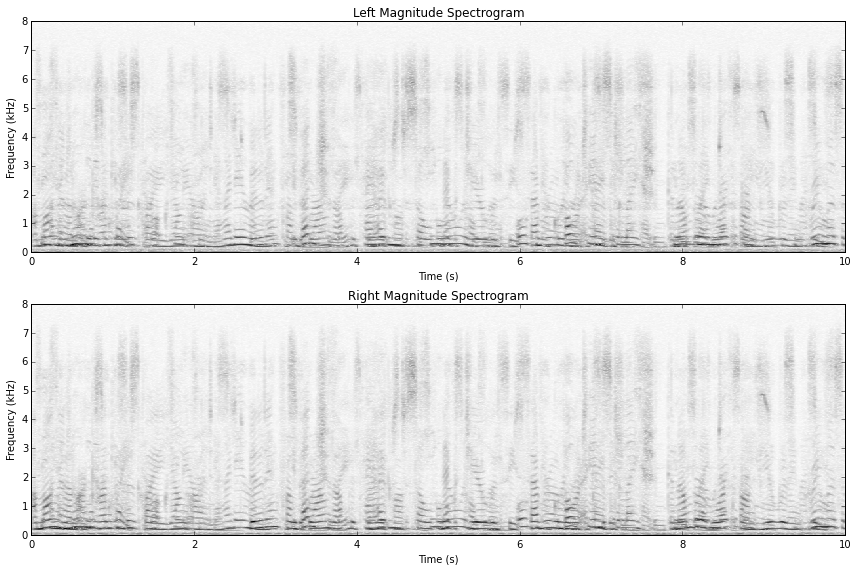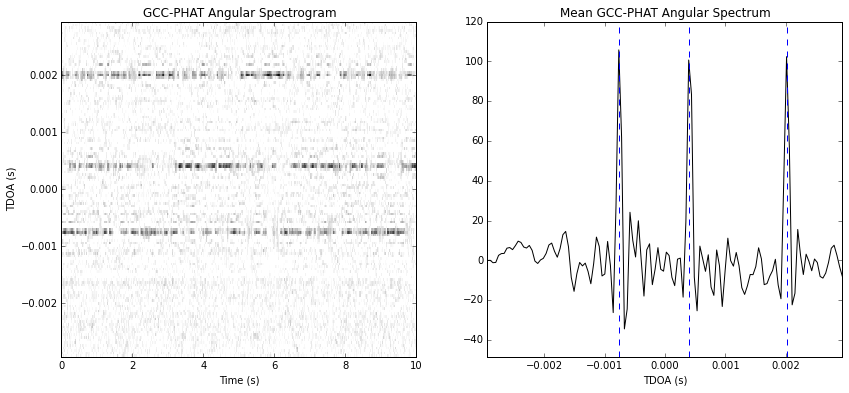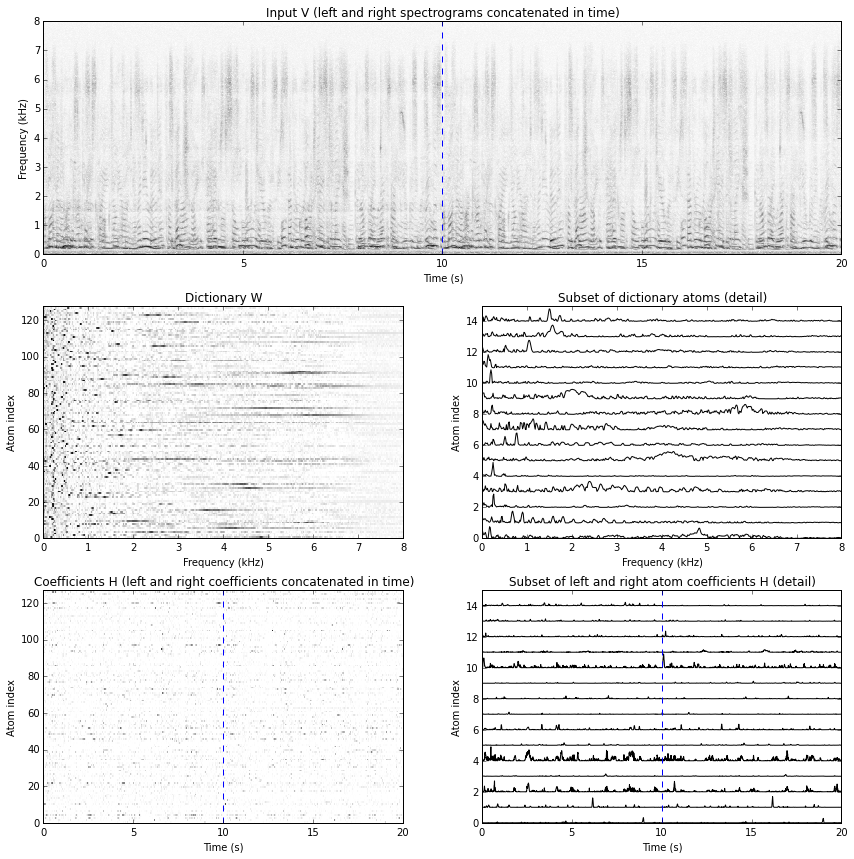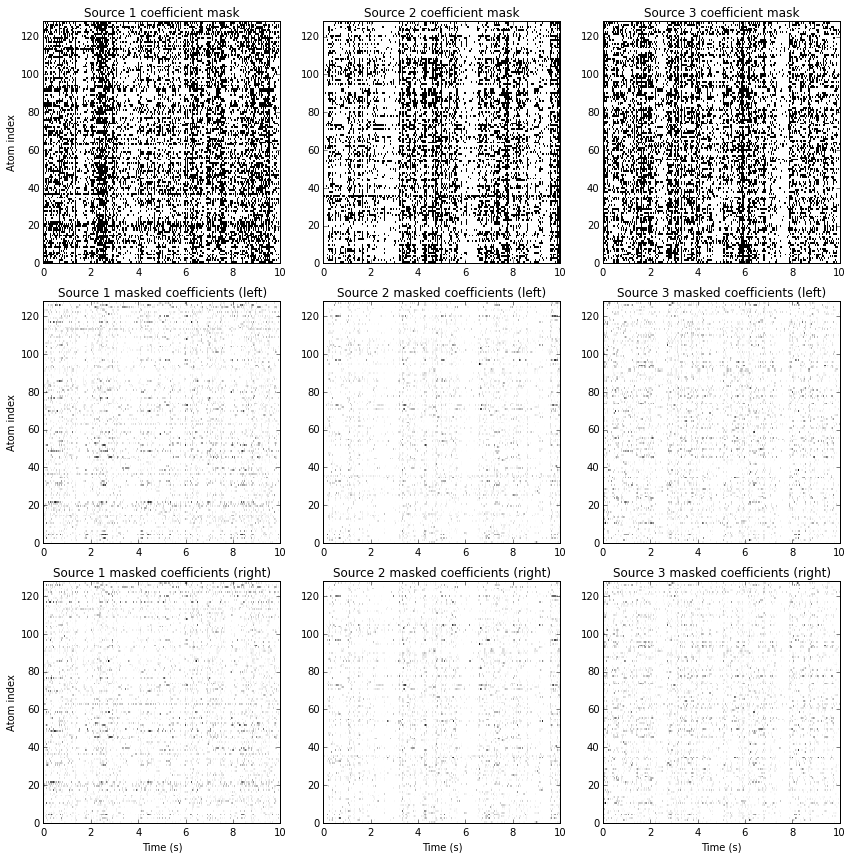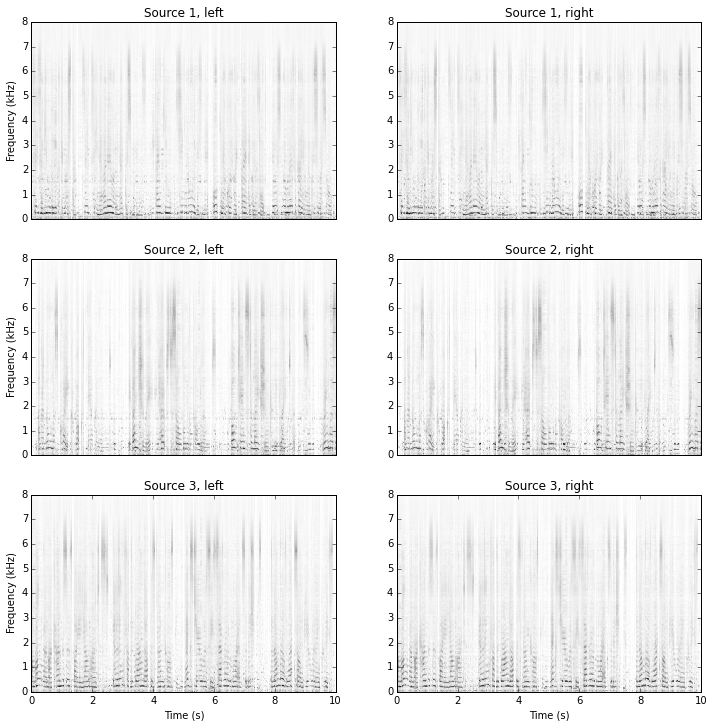To play the audio examples in this notebook, please view it with the Jupyter Notebook Viewer.
This iPython Notebook is a demo of GCC-NMF blind source separation algorithm, combining:
- Non-negative matrix factorization (NMF): unsupervised dictionary learning algorithm
- Generalized cross-correlation (GCC): source localization method
Separation is performed directly on the stereo mixture signal using no additional data:
- An NMF dictionary is first learned from the left and right mixture spectrograms, concatenated in time.
- Dictionary atoms are then attributed to individual sources over time according to their time difference of arrival (TDOA) estimates, defining a binary coefficient mask for each source.
- Masked coefficients are then used to reconstruct each source independently.
This demo separates the speech sources from the data/dev1_female3_liverec_130ms_1m_mix.wav mixture, taken from the SiSEC 2016 Underdetermined speech mixtures "dev1" dataset, and saves results to the data directory.
- Preliminary setup
- Input mixture signal
- Complex mixture spectrogram
- GCC-PHAT source localization
- NMF decomposition
- GCC-NMF coefficient mask generation
- Source spectrogram estimates reconstruction
- Source signal estimates reconstruction
from gccNMF.gccNMFFunctions import *
from gccNMF.gccNMFPlotting import *
from IPython import display
%matplotlib inline# Preprocessing params
windowSize = 1024
fftSize = windowSize
hopSize = 128
windowFunction = hanning
# TDOA params
numTDOAs = 128
# NMF params
dictionarySize = 128
numIterations = 100
sparsityAlpha = 0
# Input params
mixtureFileNamePrefix = 'data/dev1_female3_liverec_130ms_1m'
microphoneSeparationInMetres = 1.0
numSources = 3mixtureFileName = getMixtureFileName(mixtureFileNamePrefix)
stereoSamples, sampleRate = loadMixtureSignal(mixtureFileName)
numChannels, numSamples = stereoSamples.shape
durationInSeconds = numSamples / float(sampleRate)describeMixtureSignal(stereoSamples, sampleRate)
figure(figsize=(14, 6))
plotMixtureSignal(stereoSamples, sampleRate)Input mixture signal:
sampleRate: 16000 samples/sec
numChannels: 2
numSamples: 160000
dtype: float32
duration: 10.00 seconds
complexMixtureSpectrogram = computeComplexMixtureSpectrogram( stereoSamples, windowSize,
hopSize, windowFunction )
numChannels, numFrequencies, numTime = complexMixtureSpectrogram.shape
frequenciesInHz = getFrequenciesInHz(sampleRate, numFrequencies)
frequenciesInkHz = frequenciesInHz / 1000.0describeMixtureSpectrograms(windowSize, hopSize, windowFunction, complexMixtureSpectrogram)
figure(figsize=(12, 8))
plotMixtureSpectrograms(complexMixtureSpectrogram, frequenciesInkHz, durationInSeconds)STFT:
windowSize: 1024
hopSize: 128
windowFunction: <function hanning at 0x1075e8140>
complexMixtureSpectrogram.shape = (numChannels, numFreq, numWindows): (2, 513, 1243)
complexMixtureSpectrogram.dtype = complex64
spectralCoherenceV = complexMixtureSpectrogram[0] * complexMixtureSpectrogram[1].conj() \
/ abs(complexMixtureSpectrogram[0]) / abs(complexMixtureSpectrogram[1])
angularSpectrogram = getAngularSpectrogram( spectralCoherenceV, frequenciesInHz,
microphoneSeparationInMetres, numTDOAs )
meanAngularSpectrum = mean(angularSpectrogram, axis=-1)
targetTDOAIndexes = estimateTargetTDOAIndexesFromAngularSpectrum( meanAngularSpectrum,
microphoneSeparationInMetres,
numTDOAs, numSources)figure(figsize=(14, 6))
plotGCCPHATLocalization( spectralCoherenceV, angularSpectrogram, meanAngularSpectrum,
targetTDOAIndexes, microphoneSeparationInMetres, numTDOAs,
durationInSeconds )V = concatenate( abs(complexMixtureSpectrogram), axis=-1 )
W, H = performKLNMF(V, dictionarySize, numIterations, sparsityAlpha)
numChannels = stereoSamples.shape[0]
stereoH = array( hsplit(H, numChannels) )describeNMFDecomposition(V, W, H)
figure(figsize=(12, 12))
plotNMFDecomposition(V, W, H, frequenciesInkHz, durationInSeconds, numAtomsToPlot=15)Input V:
V.shape = (numFreq, numWindows): (513, 2486)
V.dtype = float32
Dictionary W:
W.shape = (numFreq, numAtoms): (513, 128)
W.dtype = float32
Coefficients H:
H.shape = (numAtoms, numWindows): (128, 2486)
H.dtype = float32
targetTDOAGCCNMFs = getTargetTDOAGCCNMFs( spectralCoherenceV, microphoneSeparationInMetres,
numTDOAs, frequenciesInHz, targetTDOAIndexes, W,
stereoH )
targetCoefficientMasks = getTargetCoefficientMasks(targetTDOAGCCNMFs, numSources)figure(figsize=(12, 12))
plotCoefficientMasks(targetCoefficientMasks, stereoH, durationInSeconds)Reconstruct source spectrogram estimates using masked NMF coefficients for each target, and each channel
targetSpectrogramEstimates = getTargetSpectrogramEstimates( targetCoefficientMasks,
complexMixtureSpectrogram, W,
stereoH )figure(figsize=(12, 12))
plotTargetSpectrogramEstimates(targetSpectrogramEstimates, durationInSeconds, frequenciesInkHz)Combine source estimate spectrograms with the input mixture spectrogram's phase, and perform the inverse STFT
targetSignalEstimates = getTargetSignalEstimates( targetSpectrogramEstimates, windowSize,
hopSize, windowFunction )
saveTargetSignalEstimates(targetSignalEstimates, sampleRate, mixtureFileNamePrefix)for sourceIndex in xrange(numSources):
figure(figsize=(14, 2))
fileName = getSourceEstimateFileName(mixtureFileNamePrefix, sourceIndex)
plotTargetSignalEstimate( targetSignalEstimates[sourceIndex], sampleRate,
'Source %d' % (sourceIndex+1) )